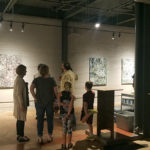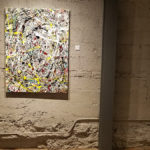Alexander/Heath Contemporary
is proud to announce
an exhibition of the work of painter
Ben Garst
August 3rd though August 31st, 2018
CLOSING RECEPTION!
Friday Night, August 24th from 7 to 9 pm
Friday Night, August 24th from 7 to 9 pm
OPENING
Art-by-Night Friday, August 3rd, 6 to 10 pm
Refreshments / Live Music
Gallery open by appointment during the summer months:
Contact via email: hettig@alexander-heath.com / 607.226.2473
Photographs of the Opening Exhibition
Human Zoochosis
“A method of painting, is a natural growth out of a need…technique is just a means at arriving at a statement.” – Jackson Pollock
Ben Garst, was born 1991 in Virginia, his first word was “look.” He attended Roanoke College, where he studied International Relations. In 2015 he moved to Florence to dedicate himself to painting. This experience illuminated him to the world of art in irrevocable way and contextualized the difference between European and American fine art. Since his return he has dedicated himself to studying 20th century American starting with the post WWII AbEx movement. Thematically, his work concerns the human condition in the information era, attempting to reconcile biology with technology, and seeing how the latter affects our psychology. He argues against the “we have arrived” mentality of 21st century thinking, in favor of a “oh look how far we have yet to go” way of perceiving history in action. His work has been shown throughout Italy and the US including Palazzo Vecchio, The British Institute of Florence, the Studio Arts Center International (SACI), as well as Roanoke’s own Taubman Museum of Fine Art. He is currently working from in his studio in Roanoke. This series represents his solo premier and is dedicated to his brother and is in memory of his mother, who inspired him to paint, and his friend Alex Freeman, for his authenticity gone too soon.
Human Zoochosis is about questions and answers, actor and observer, looking and being looked at. The series consists of 16 freeform, pareidolic portraits made through acts of anti-mimicry of the AbEx action painting of Jackson Pollock. The artist constructs a new modality of representational abstract forms exploring the relationship between actor and observer. The series reacts to the film “Jackson Pollock 51”, a famously disastrous project by the German filmmaker Hans Numeth, in which he recorded Pollock painting. The stress of the project and the demands of the film maker led Pollock to resume drinking after years of sobriety, ultimately leading to a fatal car crash years later. It offers a metaphorical microcosmic insight into the tragic life of Jackson Pollock, thereby granting us the capacity to understand our own tragedies and tragic losses. The series looks to these sources to contextualize and articulate what the artist refers to as the observed isolation, or “Human Zoochosis,” of living in the information era and the social and mental conundrums that it creates.
Each piece is made using a very specific five step process, starting with literal note-taking on the canvas to establish an emotional basis, intentionality, and initial question for the painting session. The question is covered with a rough figurative representation of itself, which is, in the third step, intentionally overworked. When the image becomes unbearable or too muddied, the canvas is removed from the easel, placed upon on the floor and covered again with paint, using a method similar Pollock’s famous drip technique, effectively hiding the underpainting. The artist laboriously examines the image in an exercise of “cloud watching,” intending to seek out an answer to the question posed in step one. If the answer does not present itself in the paintings’ current iteration, the canvas is wiped and the process starts over. Some paintings require more physical layers than others to answer the question. In this sense, the paintings are antithetical to that of Pollock’s work, in that they each have a specific focal point and are meant to be representational suggestions of portraiture, unlike the non-local, non-representational, all-over paintings that Pollock is remembered for. By virtue of the note taking and intention setting at the projects start there is a specific narrative behind each piece. There is another pivotal difference in modality at work as well: these works are on pre stretched canvas, which denies these works the crop-ability that Pollock would have enjoyed from painting on un-stretched canvas in exchange for the ability for the piece to be picked up from the floor, moved and shaken, allowing gravity to manipulate the lines and forms within the confines of the canvas square.
These paintings explore the phenomenon of how mere observation changes the way a situation or actor behaves when they become aware of being observed. Specifically, the paintings locate this phenomenon within the social context of the internet and social media, and then work the contrapositive of this formula in order to undermine it. In order to make a series that defies how we consume art through social media, these pieces are made to be appreciated only in person, something that demands an amount of observation and study greater than the social-media-art-machine is designed for. The idea is to make objects that at first glance may seem repugnant, random, and nonsensical, but after a communicative back-and-forth study, reveal their layers of inner self and hint toward the hidden dialogue underneath, a dialogue containing panoplies of small lessons and anecdotes manifested within the drips and lines. The portraits that emerge from this dialogue are the likeness of the life of the painting. The paintings possess vitality, separate from the life of the artist, and through this vitality become persons. By communicating with these persons-on-canvas, we train ourselves to see the act of mere looking as incomplete without a dialogue between observers and observed. Our contemporary social climate inundates us with the effects of mere looking without real dialogue, leading people to develop neurotic, bizarre, and self-destructive behaviors. The ease with which the other dictates a narrative for the subject and circumscribes them within it compounds and perpetuates this societal illness. The project equips agents with the ability to see past the superficiality of mere observation of that which is immediately available to better understand the hidden dialogue which we all have behind our socially defined self-portrayal, so as to prevent the tragedy of one becoming nothing more than another of the other’s inauthentic determinations. “Méfiez-vous du rêve de l’autre, parce que si vous êtes pris dans le rêve de l’autre, vous êtes foutu.”
The pedagogical element of this series teaches a method anyone can exercise as a means of seeking catharsis for dealing with intense emotionality. The physical-conversational dance, the act of creation of a piece in this method, can cleanse your mind by dirtying your hands, feet, clothes and anything else that you might get covered in paint through this method. Through the series of addition and subtraction of layers within the emotional context the painter sets for the session, one reexamines questions and find answers in forms that they would have never imagined. Once finished the piece acts as a meditative reminder of those feeling that can be reexamined to elucidate new answers over time. Whereas the painting may be formed out of pain, being able to gaze upon that feeling allows us to continually reassess answers to now simple questions of the past which at the time plagued us to no end.
Ben Garst
July 2018









